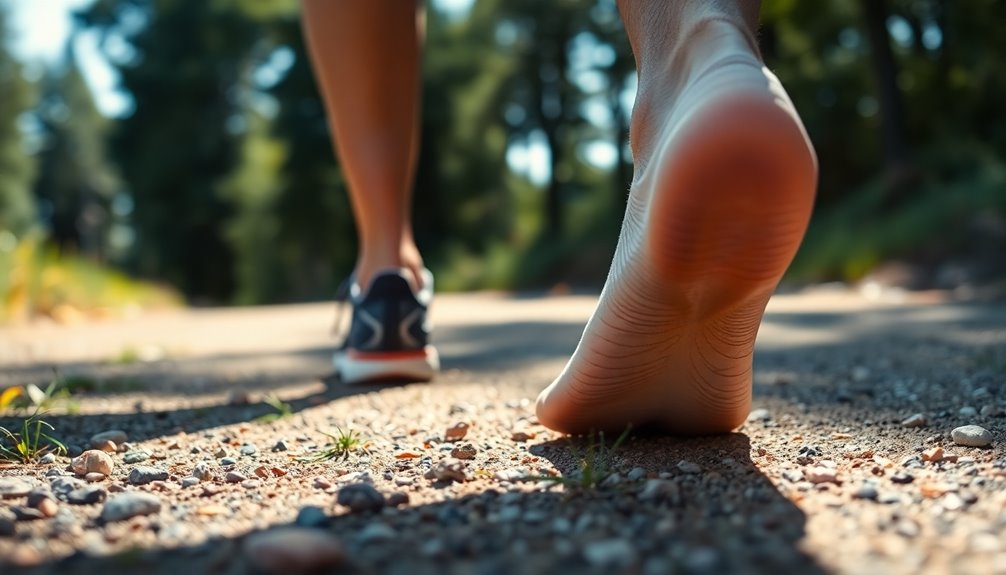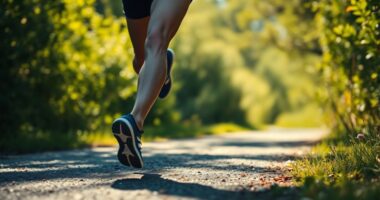Barefoot running can strengthen your foot muscles, improve your running mechanics, and enhance balance. However, it also carries risks like calf strain and impact injuries, especially if you shift too quickly. Blisters and environmental hazards may also pose challenges. Gradually incorporating barefoot techniques into your routine is essential to avoid injury. If you're curious about finding the right minimalist shoes and gaining expert insights, you'll want to explore more on this topic.
Key Takeaways
- Pros: Barefoot running strengthens foot muscles and improves running mechanics, promoting a more natural gait and potentially reducing injury risk.
- Pros: Engaging intrinsic foot muscles enhances foot function and stability, boosting balance and proprioception during running.
- Cons: Rapid transition to barefoot running can lead to calf strain and Achilles tendinitis, making gradual adaptation crucial.
- Cons: Lack of cushioning increases the risk of impact-related injuries and blisters, as the feet adjust to new conditions.
- Cons: Environmental hazards, such as sharp objects, pose risks when running barefoot, necessitating careful attention to surroundings.
What Is Barefoot Running?

Barefoot running is a style of running that involves going without traditional shoes, which promotes a more natural gait and encourages a forefoot strike instead of a heel-first landing.
By adopting this method, you may notice shorter strides and a faster cadence, enhancing your athletic performance while reducing harmful braking forces.
The practice gained traction from the book "Born to Run," showcasing the low injury rates among the Tarahumara tribe, famous for their barefoot running.
Shifting to barefoot running can strengthen your intrinsic foot muscles, improving overall foot function, stability, and arch height.
While the benefits of barefoot running are appealing, it's essential to adapt gradually to minimize injury risk and enhance your running form effectively.
The Rise of Minimalist Shoes

As the popularity of barefoot running surged, minimalist shoes emerged as a practical alternative for those seeking a more natural running experience without going completely shoeless.
These lightweight options typically feature less than 8 mm heel-to-toe drop, promoting a running technique that mimics barefoot mechanics. Brands like Vibram and New Balance have developed minimalist shoes tailored for various activities, enhancing stability and arch support while allowing for improved ground feel and foot splay.
This design encourages a more natural foot strike pattern, which can aid in injury prevention. Additionally, proper fit is essential; minimalist shoes must accommodate your unique foot shape and arch height for maximum comfort, ensuring you get the most out of your running experience.
Benefits of Barefoot Running

Many runners find that embracing barefoot running brings a wealth of benefits, from strengthening foot muscles to improving overall running mechanics.
When you run barefoot, you often adopt a natural forefoot strike, which can help reduce injury by minimizing ground reaction forces. This style engages your intrinsic muscles, enhancing foot function and structure while potentially alleviating issues like plantar fasciitis and Achilles tendon problems.
Additionally, barefoot running boosts your balance and proprioception, making you more aware of your movements. As a result, you may notice improved running efficiency and speed, thanks to a shorter stride and faster cadence.
Potential Drawbacks of Barefoot Running

While the allure of barefoot running is undeniable, it's essential to evaluate the potential drawbacks that come with this approach. Shifting too quickly can lead to calf strain and Achilles tendinitis due to increased stress on your muscles and tendons. The lack of cushioning raises the risk of impact-related injuries like stress fractures and plantar fasciitis, especially if you're not used to barefoot running. Blisters often arise during the initial weeks as your skin adjusts to the increased friction. Additionally, environmental hazards, such as sharp objects, can cause cuts and abrasions. Monitoring discomfort is vital, as proper adaptation is key to preventing these issues.
| Drawback | Description | Prevention |
|---|---|---|
| Calf Strain | Increased stress on calf muscles | Gradual adjustment |
| Blisters | Skin not conditioned for increased friction | Allow time for adaptation |
| Impact-Related Injuries | Higher risk due to lack of cushioning | Strengthening exercises |
| Environmental Hazards | Cuts from sharp objects | Choose safe running areas |
Transitioning to Barefoot Running

Shifting to barefoot running requires careful planning to avoid injuries and guarantee a smooth adjustment. A gradual change is essential for developing your foot muscles and preventing discomfort.
Here are some tips to help you:
- Start with short distances on softer surfaces like grass or rubber tracks.
- Increase your barefoot running distance by no more than 10% each week.
- Incorporate barefoot running into your existing training plan to ease into it.
- Monitor discomfort closely; any persistent pain may signal a need to adjust your approach.
- Consult a fitness professional for personalized guidance based on your individual foot mechanics.
Choosing the Right Minimalist Shoes

How can you find the perfect minimalist shoes for your running journey? Start by looking for lightweight shoes that mimic the feeling of running barefoot.
A lower heel-to-toe drop (8 mm or less) encourages a natural foot position and promotes midfoot or forefoot striking. This can help reduce your injury risk.
Confirm the shoes have a flexible sole to allow natural foot movement, while a broad design supports foot splay, improving your balance and proprioception.
It's crucial to choose minimalist shoes that fit your foot shape and arch height for comfort and performance.
Remember to gradually shift into your new shoes, beginning with shorter distances and slowly increasing your mileage to help your feet and lower limbs adapt.
Expert Insights on Injury Prevention

As you commence your barefoot running journey, understanding injury prevention is key to enjoying the experience.
To minimize the risk of injuries like Achilles tendonitis, follow these expert insights:
- Gradually increase your running distance to allow foot muscles to adapt.
- Focus on proper running form, aiming for midfoot or forefoot landing to avoid heel striking.
- Consult a physical therapist for tailored injury risk assessments based on your foot structure and biomechanics.
- Incorporate foot strengthening exercises and flexibility training to build resilience.
- Regularly evaluate your body mechanics and previous injury history to adjust your training approach.
Frequently Asked Questions
Is Barefoot Running Actually Good for You?
Barefoot running can be good for you, but it depends on your body and how you changeover.
You might strengthen your foot muscles and improve balance by engaging more of your foot's natural structure. It encourages a more natural running form, which can help reduce injury risks.
However, if you switch too quickly, you could face problems like stress fractures.
It's important to assess your foot structure and adapt gradually for the best results.
What Are the Disadvantages of Barefoot Running?
When you consider barefoot running, several disadvantages pop up.
You might face an increased risk of injuries, like stress fractures and Achilles tendonitis, due to the lack of cushioning. Blisters and discomfort can occur as your feet adapt, especially in the beginning.
Plus, without protective footwear, sharp objects could injure your feet.
Finally, if you have narrow feet, finding a secure fit in minimalist shoes might be tough, leading to instability.
What Are the Negatives of Barefoot?
When you step into the world of barefoot experiences, you might encounter a few bumps along the way.
You could find that your feet feel a little sore as they adapt, and blisters may pop up unexpectedly.
Plus, without those cozy shoes, your feet might face a bit more risk from sharp objects.
And if your feet aren't a perfect fit for barefoot shoes, you might feel a tad wobbly while you run.
Is It Better to Run Barefoot or With Shoes On?
Deciding whether to run barefoot or with shoes really depends on your individual needs and preferences.
If you enjoy feeling the ground and want to strengthen your foot muscles, barefoot running could be beneficial.
On the other hand, if you prefer cushioning and support, shoes might be the way to go.
Listen to your body and consider your foot structure and running style to make the best choice for your own running experience.
Conclusion
So, you're thinking about ditching those cushy running shoes for a barefoot experience? Ironically, while you might love the feel of the ground beneath your feet, your calves might not share the same enthusiasm. Embracing barefoot running can be liberating, but remember, it's not all sunshine and rainbows. With the right approach, you can enjoy the benefits while minimizing the risks. After all, who wouldn't want to run like our ancestors—but without the foot pain?









